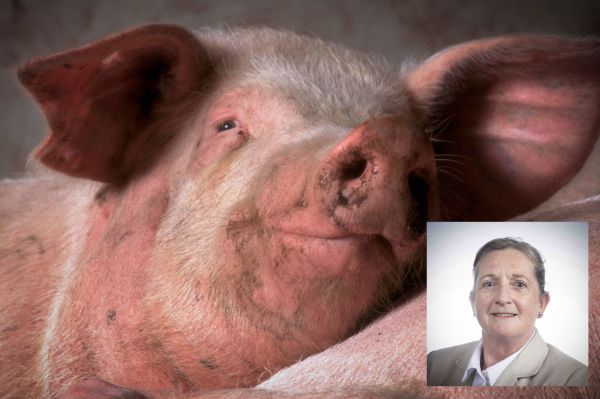New challenges in the control of PRRS

PRRS is one of the more difficult swine diseases to control. In recent years, new strains have emerged in Spain and the US causing devastating welfare and economic problems for affected farms. It’s been reported that over 18 million pigs have been affected by the Rosalia strain in Northern Spain. The new strain is highly pathogenic with a particular effect on breeding stock with high rates of mortality in sows, abortion storms, and stillborn piglets.
PRRS is a single strand RNA virus and, like Covid-19 in humans and influenza in pigs, it multiplies as it passes through its host, changing or mutating very slightly. If this occurs when other similar virus strains are also circulating, it can recombine creating a new strain. Rosalia is made up of at least four different PRRS fragments found across Europe.
Although it’s unlikely that this particular strain will reach Ireland any time soon, pig farmers shouldn’t be complacent about PRRS. The industry needs to be vigilant to the risks and alert to the potential emergence of new strains. Farmers and vets should report any unusual features of disease in their pigs.
‘Blue ear’
PRRS, also known as blue ear, first occurred in Europe in the early 1990s and is, generally, controlled through strict biosecurity and vaccination, as complete eradication is difficult to achieve. Herd-to-herd transmission of PRRS can occur following the introduction of infected animals or the use of infected semen. The virus can also be spread via contaminated equipment and there are reports that the virus can spread on the wind for up to 3km. The proximity of other farms and the movement of lorries are believed to have been an important factor in the transmission of the Rosalia strain in Spain. Strict biosecurity and cleaning regimes are essential to reduce the risk of PRRS transmission. Acquired immunity continues to be the best protection against PRRS. As we see with Covid 19 in human health, vaccination protects against the effects of the virus and works best when all animals in the herd are vaccinated.
Protecting the entire herd
Sows should receive regular PRRS vaccination, either during each reproductive cycle on a ‘6-and-60’ programme, or at regular intervals as part of a blanket immunisation programme. Gilts or sows continue to shed virus for a short time post-vaccination as their immunity develops. This time period will depend on the individual vaccines, but ideally use a stable, low-shedding vaccine.
Gilt management is key to stability of the breeding herd. Gilts may have been exposed to disease and still be potentially infected with field strain of PRRS, so need to be immunised prior to joining the rest of the breeding herd. Early selection is recommended to allow the full course of vaccine to be administered and allow a suitable interval prior to service to allow immunity development. Your vet will advise the recommended procedure for your farm.
Farmers should always discuss their vaccination regime with their vet who can also advise on diagnostics, herd health, and on-farm biosecurity.
Protecting the entire herd
Sows should receive regular PRRS vaccination, either during each reproductive cycle on a ‘6-and-60’ programme, or at regular intervals as part of a blanket immunisation programme. Gilts or sows continue to shed virus for a short time post-vaccination as their immunity develops. This time period will depend on the individual vaccines, but ideally use a stable, low-shedding vaccine.
Gilt management is key to stability of the breeding herd. Gilts may have been exposed to disease and still be potentially infected with field strain of PRRS, so need to be immunised prior to joining the rest of the breeding herd. Early selection is recommended to allow the full course of vaccine to be administered and allow a suitable interval prior to service to allow immunity development. Your vet will advise the recommended procedure for your farm.
Even on farms that are vaccinating sows and gilts, if there is a small break in biosecurity or if the PRRS virus is present anywhere on the farm, the rest of the herd is at risk. Piglets that are not vaccinated are particularly susceptible to the disease and it can also circulate within second stage and fattener groups.
The PRRS virus also acts as a gateway to a whole host of bacterial respiratory diseases. If PRRS infection occurs in young pigs, the suppression of their immunity can be immense and we often see Mycoplasma, Streptococcus suis, Actinobacillus pleuropneumonia, and Glässer’s disease following on throughout the growing and finishing phases. Speak to your vet if you are concerned about respiratory disease on your farm, they will be able to run tests to give a comprehensive diagnosis of this complex issue.
New advice for PRRS vaccination
A range of commercial live vaccines against PRRS is available to farmers in Ireland. The European Medicines Agency (EMA) recently recommended general guidelines to ensure the safe use of these vaccines, to mitigate the risk and the frequency of recombination between PRRS viruses including PRRS vaccine strains.
All pig farmers are now advised to:
- Only vaccinate healthy animals;
- Only use one vaccine throughout the herd, avoiding the use of two different companies’ vaccines for breeders and rearing piglets;
- Select a vaccine with a reduced and self-limiting shedding period of the vaccine virus (information available in the SPC);
- Respect a transition time before introducing a new vaccine, and if needed, to undertake diagnostics to confirm the absence of any other vaccine or field virus strain circulating on farm; and
- Speak to their vet about the new EMA guidelines before making any changes, in order to identify the best vaccination programme for their farm.





